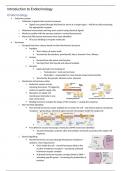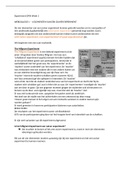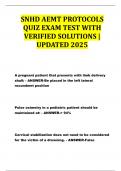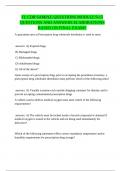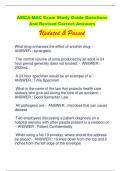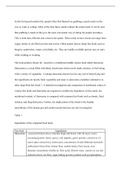Endocrinology
Endocrine system
o Collection of glands that secrete hormones
Signals are passed through the blood to arrive at a target organ – which has cells possessing
the appropriate receptor
o Maintains homeostasis and long-term control using chemical signals
o Works in parallel with the nervous system to control homeostasis
o More than fifty human hormones have been identified
All act by binding to receptor molecules
Hormones
o Grouped into three classes based on their biochemical structure
Peptides
Short chains of amino acids
Secreted by the pituitary, parathyroid, heart, stomach, liver, kidneys
Amines
Derived from the amino acid tyrosine
Secreted from the thyroid and adrenal medulla
Steroids
Lipids derived from cholesterol
o Testosterone = male sex hormone
o Oestradiol – responsible for many female sexual characteristics
Secreted by the gonads, adrenal cortex, placenta
o Mechanism of hormone action
Endocrine system acts by
releasing hormones triggering
actions in specific target cells
Receptors on target cell
membranes bind only to one
type of hormone
Binding hormone changes the shape of the receptor = causing the response
o Non-steroidal signalling
Non-steroid hormones (water soluble) do not enter the cell – but bind to plasma membrane
receptors = generating a chemical signal (second messenger) inside the target cell
Five different second messenger chemicals (cAMP) have been identified
Second messengers activate other intracellular chemicals to produce the target cell
response
o Steroid signalling
Steroid hormones can pass through the plasma membrane –
acting in a two-step process
Once inside the cell – steroid hormones bind to the
nuclear membrane receptors = producing activated
hormone-receptor complex
Activated hormone-receptor complex binds to DNA =
activating specific genes – increasing the production of
proteins
, Introduction to Endocrinology
Endocrine-related problems
o Overproduction of a hormone
o Underproduction of a hormone
o Non-functional receptors = cause target cells to become insensitive to hormones
Pituitary gland
o Majority of endocrine control comes from pituitary gland
Protected at base of the brain in the sphenoid bone
– connected by pituitary stalk
o Pituitary gland development
Forms from a downgrowth of the base of the brain
(diencephalon) and upgrowth from the roof of the
mouth = forming Rathke’s pouch
Two tissues fold around one another = forming neurohypophysis (posterior pituitary) and
adenohypophysis (anterior pituitary)
Posterior pituitary
o Elongated nerve fibres
o In the hypothalamus – there is:
Large bodied neurons = magnocellular neurons – in paraventricular
nucleus
Send axonal productions to posterior pituitary
o Hormones are made here and transported down
neural pathways to posterior pituitary via pituitary
stalk
o Hormones – synthesised in cell bodies of magnocellular neurons (PVN and
SON) + axonal transported from hypothalamus to posterior pituitary
Oxytocin
Vasopressin = anti-diuretic hormone (ADH)
Anterior pituitary
o Produced a whole array of hormones that target many different tissues in
the body
o Regulated by hypothalamic releasing hormones that stimulate the anterior
pituitary to produce different hormones
Each hormone has particular signals in the hypothalamus that
regulate their synthesis and secretion
o Work on target tissues that produce other hormones that feedback and
control endocrine cycle
o Hormones
TSH, LS, FSH
Heterodimeric glycoproteins
Common alpha-subunit
Specific beta-subunits (TSH-beta, LH-beta, FSH-beta)
ACTH
39aa fragment of POMC
GH and PRL
190aa peptides – internal di-S bonds
Homologous receptors
Intermediate lobe
o Closely associated with posterior pituitary
o Separated from the anterior lobe by the hypophyseal cleft
o Shows variation in size among species
Produces melanocyte-stimulating hormone = involved in skin colour

